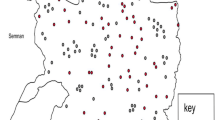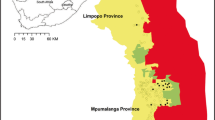Abstract
Foot and mouth disease (FMD) is recognized as an endemic disease in Thailand and throughout other countries in Southeast Asia. The underreporting of FMD outbreaks has affected the true status of the disease. This study aimed to determine the number of dairy farms in Chiang Mai that had experienced FMD outbreaks (FMD outbreak farm) during 2015–2016 using capture-recapture (CR) methods. Two independent FMD outbreak data sources including data from the livestock authorities and survey questionnaires were analyzed using Chapman estimator and Chao estimator. Results showed that the estimated number of FMD outbreak farms was 264 (95% CI = 250, 277) and 273 (95% CI = 259, 292) farms based on the Chapman estimator and Chao estimator, respectively. The estimated prevalence of FMD corresponding to the Chapman estimator was lower than the Chao estimator. The active approach of the survey method offered a higher degree of sensitivity compared to the passive method used by the livestock authorities. Estimations from the CR method provided an upper bound for the true number of outbreak farms. This study demonstrated the use of the CR method to estimate the true status of FMD outbreaks. Our proposed approach can potentially be used as a tool to enhance the accuracy and sensitivity of established monitoring and surveillance systems.



Similar content being viewed by others
References
Arjkumpa, O.; Yano, T.; Prakotcheo, R.; Sansamur, C.; Punyapornwithaya, V., 2020. Epidemiology and National Surveillance System for Foot and Mouth Disease in Cattle in Thailand during 2008–2019. Vet. Sci. 7, 99.
Ballivet, S., Salmi, L. R., & Dubourdieu, D., 2000. Capture-recapture method to determine the best design of a surveillance system. Application to a thyroid cancer registry. European Journal of Epidemiology, 16(2), 147–153. https://doi.org/10.1023/A:1007605122984
Blacksell, S. D., Siengsanan-Lamont, J., Kamolsiripichaiporn, S., Gleeson, L. J., & Windsor, P. A., 2019. A history of FMD research and control programmes in Southeast Asia: Lessons from the past informing the future. Epidemiology and Infection, 147, e171. https://doi.org/10.1017/S0950268819000578
Boender, T. S., Op de Coul, E., Arends, J., Prins, M., van der Valk, M., van der Meer, J. T. M., van Benthem, B., Reiss, P., & Smit, C., 2020. Acute hepatitis C infection among adults with HIV in the Netherlands between 2003 and 2016: a capture–recapture analysis for the 2013 to 2016 period. Euro Surveillance, 25(7):pii=1900450. https://doi.org/10.2807/1560-7917.ES.2020.25.7.1900450
Braeye, T., Verheagen, J., Mignon, A., Flipse, W., Pierard, D., Huygen, K., Schirvel, C., & Hens, N., 2016. Capture-recapture estimators in epidemiology with applications to Pertussis and Pneumococcal Invasive Disease surveillance. PLOS ONE 11(10): e0165351. https://doi.org/10.1371/journal.pone.0165351
Brenner, H., 1995. Use and limitations of the capture-recapture method in disease monitoring with two dependent sources. Epidemiology, 6(1), 42–48. https://doi.org/10.1097/00001648-199501000-00009
Brenner, H., 1996. Effects of misdiagnoses on disease monitoring with capture-recapture methods. Journal of Clinical Epidemiology, 49(11), 1303–1307. https://doi.org/10.1016/0895-4356(95)00026-7
Brittain, S., & Böhning, D., 2009. Estimators in capture–recapture studies with two sources. Advances in Statistical Analysis, 93(1), 23–47. https://doi.org/10.1007/s10182-008-0085-y
Cameron, A.R., 1997. Active surveillance and GIS as components of an animal health information system for developing countries – Thailand and Laos as examples. University of Queensland. http://www.ausvet.com.au/content.php?page=bookactivesurveillanceandgis.
Cameron, A.R., 1999. Survey toolbox for livestock diseases: A practical manual and software package for active surveillance in developing countries. http://aciar.gov.au/publication/MN054.
Chapman, C., 1951. Some properties of the hypergeometric distribution with applications to zoological censuses. University of California Publications in Statistics, 1, 131–160.
Chiang Mai Provincial Livestock Office, 2019. Provincial FMD outbreak report base on national animal disease surveillance system (NADSS) (in Thai). Department of Livestock Development (DLD): Bangkok, Thailand.
Christopoulos, D., 2009. “Peer Esteem Snowballing: A Methodology for expert surveys” In: Eurostat Conference for new techniques and technologies for statistics, Brussels, Conference Proceedings, 171–179.
DLD, 2016. Annual Department of Livestock Development Animal Health Action Plan. Department of Livestock Development (DLD): Bangkok, Thailand, 2016; pp. 1-11.
Eid, D., Guzman-Rivero, M., Rojas, E., Goicolea, I., Hurtig, A.-K., Illanes, D., & San Sebastian, M., 2018. Assessment of a Leishmaniasis reporting system in Tropical Bolivia using the capture-recapture method. The American Journal of Tropical Medicine and Hygiene, 98(1), 134–138. https://doi.org/10.4269/ajtmh.17-0308
FAO. Case definition in Livestock. 2010. http://www.fao.org/3/al859e/al859e00.pdf. Accessed on 3 January 2020.
Gerritse, S. C., Heijden, P., & Bakker, B.M., 2015. Sensitivity of population size estimation for violating parametric assumptions in log-linear models, Journal of Official Statistics, 31(3), 357-379. https://doi.org/10.1515/jos-2015-0022
Gleeson, L.J., 2002. A review of the status of foot and mouth disease in South-East Asia and approaches to control and eradication, Scientific and Technical Review of the Office International des Epizooties, 21(3), 465-472. https://doi.org/10.20506/rst.21.3.1346
Gunarathne, A., Kubota, S., Kumarawadu, P., Karunagoda, K., & Kon, H., 2016. Is hiding Foot and Mouth Disease sensitive behavior for farmers? a survey study in Sri Lanka. Asian-Australasian Journal of Animal Sciences, 29(2), 280–287. https://doi.org/10.5713/ajas.15.0241
Hardstaff, J. L., Clough, H. E., Harris, J. P., Lowther, J. A., Lees, D. N., & O’Brien, S. J., 2018. The use of capture-recapture methods to provide better estimates of the burden of norovirus outbreaks from seafood in England, 2004-2011. Epidemiology and Infection, 147, 1–7. https://doi.org/10.1017/S0950268818003217
Kazerooni, P. A., Fararouei, M., Nejat, M., Akbarpoor, M., & Sedaghat, Z., 2018. Under-ascertainment, under-reporting and timeliness of Iranian communicable disease surveillance system for zoonotic diseases. Public Health, 154, 130–135. https://doi.org/10.1016/j.puhe.2017.10.029
Kivaria, F. M., & Noordhuizen, J. P. T. M., 2010. Capture–recapture analysis of East Coast fever in smallholder dairy herds in the Dar es Salaam region of Tanzania. The Veterinary Journal, 184(2), 187–193. https://doi.org/10.1016/j.tvjl.2009.01.023
Knight-Jones, T. J. D., & Rushton, J., 2013. The economic impacts of foot and mouth disease – What are they, how big are they and where do they occur? Preventive Veterinary Medicine, 112(3–4), 161–173. https://doi.org/10.1016/j.prevetmed.2013.07.013
Madin, B., 2011. An evaluation of Foot-and-Mouth Disease outbreak reporting in mainland South-East Asia from 2000 to 2010. Preventive Veterinary Medicine, 102(3), 230–241. https://doi.org/10.1016/j.prevetmed.2011.07.010
Murphy, C. C., Trevathan, E., & Yeargin-Allsopp, M., 1995. Prevalence of epilepsy and epileptic seizures in 10-year-old children: results from the Metropolitan Atlanta Developmental Disabilities Study. Epilepsia, 36(9), 866–872. https://doi.org/10.1111/j.1528-1157.1995.tb01629.x
Paton, D. J., Gubbins, S., & King, D. P. (2018). Understanding the transmission of foot-and-mouth disease virus at different scales. Current Opinion in Virology, 28, 85–91. https://doi.org/10.1016/j.coviro.2017.11.013
Pledger, S., 2005. The Performance of mixture models in heterogeneous closed population capture–recapture. Biometrics, 61(3), 868–873. https://doi.org/10.1111/j.1541-020X.2005.00411_1.x
Poorolajal, J., Mohammadi, Y., & Farzinara, F., 2017. Using the capture-recapture method to estimate the human immunodeficiency virus-positive population. Epidemiology and Health, 39, e2017042–e2017042. https://doi.org/10.4178/epih.e2017042
R Core Team, 2019. R: A language and environment for statistical computing. R Foundation for Statistical Computing, Vienna, Austria.
Ramanoon, S. Z., Robertson, I. D., Edwards, J., Hassan, L., & Md Isa, K., 2013. Outbreaks of foot-and-mouth disease in Peninsular Malaysia from 2001 to 2007. Tropical Animal Health and Production, 45(2), 373–377. https://doi.org/10.1007/s11250-012-0226-x
Rivest, L.P., & Baillargeon, S., 2019. Rcapture: Loglinear Models for Capture-Recapture Experiments. R package version 1.4-3. https://CRAN.R-project.org/package=Rcapture
Sackett, D. L., 1997. Evidence-based medicine. Semin Perinatol, 21(1), 3–5. https://doi.org/10.1016/s0146-0005(97)80013-4
Seber, G. A. F., 1982. The Estimation of Animal Abundance and Related Parameters (2nd edition.). MacMillan, New York, USA.
Sukrat, B., Okascharoen, C., Rattanasiri, S., Aekplakorn, W., Arunakul, J., Saejeng, K., Böhning, D., & Thakkinstian, A., 2020. Estimation of the adolescent pregnancy rate in Thailand 2008-2013: an application of capture-recapture method. BMC Pregnancy and Childbirth, 20(1), 120–120. https://doi.org/10.1186/s12884-020-2808-3
Tum, S., Robertson, I. D., Edwards, J., Abila, R., & Morzaria, S., 2015. Seroprevalence of foot-and-mouth disease in the southern provinces of Cambodia. Tropical Animal Health and Production, 47(3), 541–547. https://doi.org/10.1007/s11250-015-0760-4
Tyers, M., 2019. recapr-package: Estimating, testing, and simulating abundance in a mark-recapture experiment. https://rdrr.io/github/mbtyers/recapr/man/recapr-package.html#heading-2. Accessed on 3 January 2020.
Vergne, T, Grosbois, V., Durand, B., Goutard, F., Bellet, C., Holl, D., Roger, F., & Dufour, B., 2012. A capture–recapture analysis in a challenging environment: assessing the epidemiological situation of foot-and-mouth disease in Cambodia. Preventive Veterinary Medicine, 105(3), 235–243. https://doi.org/10.1016/j.prevetmed.2011.12.008
Vergne, T, Del Rio Vilas, V. J., Cameron, A., Dufour, B., & Grosbois, V., 2015. Capture–recapture approaches and the surveillance of livestock diseases: a review. Preventive Veterinary Medicine, 120(3), 253–264. https://doi.org/10.1016/j.prevetmed.2015.04.003
Wickham, H., 2016. ggplot2: Elegant Graphics for Data Analysis. Springer-Verlag New York, New York.
Yano, T., Premashthira, S., Dejyong, T., Tangtrongsup, S., & Salman, M. D., 2018. The effectiveness of a Foot and Mouth Disease outbreak control programme in Thailand 2008–2015: case studies and lessons learned. Veterinary Sciences, 5(4), 101. https://doi.org/10.3390/vetsi5040101
Acknowledgments
We would also like to acknowledge all of the participating dairy cooperatives located in Chiang Mai and the Chiang Mai Provincial Livestock Office for providing relevant data. Furthermore, we gratefully acknowledge all dairy farmers who were willing to be interviewed as part of this study. Additionally, we gratefully recognize all participants in this study for their involvement and for providing us with relevant field data. In addition, our sincere appreciation is offered to Professor Karl Hans Zessin for his valuable guidance.
Funding
This study received financial support from the Participatory One Health Disease Detection (PODD), Veterinary Public Health and Food Safety Centre for the Asia Pacific, Faculty of Veterinary Medicine, Chiang Mai University, Thailand. We express our sincere gratitude for the financial support and the highly valuable technical and logistical support we received from this agency.
Author information
Authors and Affiliations
Corresponding author
Ethics declarations
Statement on animal rights
The questionnaire survey and research proposal of this study received approval from the Ethical Review Committee. Furthermore, Chiang Mai University Research Ethics Committee has reviewed and approved the research proposal based on international guidelines for human research protection (COA No. 008/60). The questionnaire survey participants were dairy farmers who willingly gave their informed consent to participate in the interviews. No samples were obtained from animals during the course of this research study.
Conflict of interest
The authors declare that they have no competing interests.
Additional information
Publisher’s note
Springer Nature remains neutral with regard to jurisdictional claims in published maps and institutional affiliations.
Supplementary information
ESM 1
(DOCX 13 kb)
Rights and permissions
About this article
Cite this article
Sansamur, C., Wiratsudakul, A., Charoenpanyanet, A. et al. Estimating the number of farms experienced foot and mouth disease outbreaks using capture-recapture methods. Trop Anim Health Prod 53, 12 (2021). https://doi.org/10.1007/s11250-020-02452-x
Received:
Accepted:
Published:
DOI: https://doi.org/10.1007/s11250-020-02452-x




